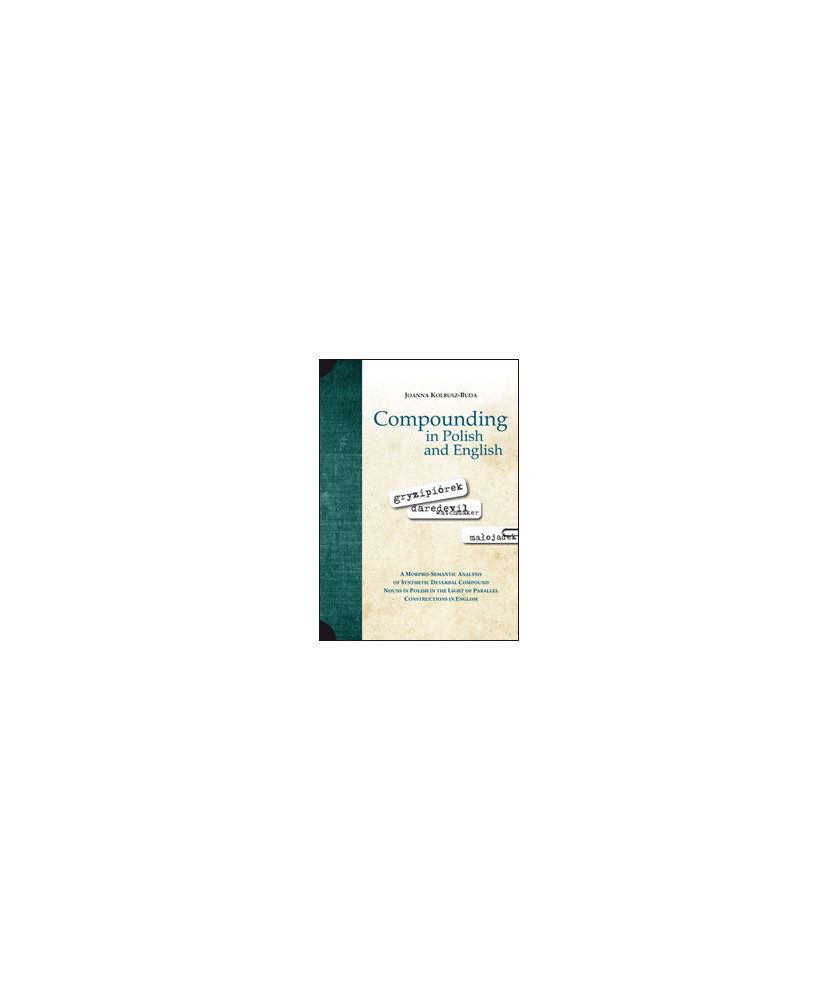
#Compounding in Polish and English. A Morpho-Semantic Analysis of Synthetic Deverbal Compound Nouns in Polish in the Light
Joanna Kolbusz-Buda
ISBN: 978-83-7702-951-0
Stron: 182
Format: B5
Rok wydania: 2014
TABLE OF CONTENT
Acknowledgements
INTRODUCTION
CHAPTER I. COMPOSITION IN POLISH
1.1. The degree of nativeness of Polish compounding
1.2. The issue of paraphrase and paraphrasing strategies
1.3. The relevance of compound-internal coalescence for the classification of Polish composites
1.3.1. Juxtapositions
1.3.2. Dvandvas
1.3.3. Solid compounds
1.3.4. Compounds Proper
1.4. Peripheral categories of Polish composition
1.4.1. Prepositional and prefixal derivatives
1.4.2. Acronyms and blends
1.5. Approaches to neoclassical compounds
1.6. Composition versus derivation
1.7. Other research perspectives
CHAPTER II. THEORIES OF COMPOUNDING IN ENGLISH
2.1. Definition and criteria for compoundhood
2.1.1. What is compound?
2.1.2. Criteria of compoundhood
2.1.2.1. A phonological criterion
2.1.2.2. The inseparability test
2.1.2.3. Compound words versus syntactic phrases
2.1.2.4. Compound-internal inflection
2.1.2.5. The interfix
2.1.2.6. Right- and left-headedness in compounding
2.1.2.7. Recursiveness
2.1.2.8. Other criteria for compoundhood
2.2. Classification of compounds
2.2.1. Root compounds
2.2.2. Synthetic compounds
2.2.3. Phrasal compounds
2.3. The relevance of headedness and percolation for the mo rpho-semantics of endocentric and exocentric compounds
2.3.1. The head of a compound
2.3.2. Morphosyntactic feature percolation
2.3.3. The position of the head and other head-related issues
2.4. An overview of word-formation approaches within the generative framework and their relevance for compounding
2.4.1. The place of compounding in the Lexicalist Hypothesis
2.4.1.1. The status of an affix in the Lexicalist Theory
2.4.1.2. Syntactic models ol word formation
2.4.1.3. Lexicalist and 'half-lexicalisf theories of word formation
2.4.2. Synthetic compounds: an overview of approaches
CHAPTER III. A MORPHO-SEMANTIC ANALYSIS OF POLISH AND ENGLISH SYNTHETIC DEVERBAL COMPOUND NOUNS
3.1. Preliminaries: in search of a method
3.1.1. The framework
3.1.1.1. Cases of Morhology-Syntax interaction
3.1.1.2. The Limited Access Principle
3.1.2. The left-branching versus right-branching structure of synthetic compounds
3.1.3. Semantic argument assignment
3.1.3.1. Co-indexation of semantic arguments and One-to-One Mapping Principle
3.1.4. The polysemy of affixes and the argument structure of compound words
3.1.5. The inventory of semantic roles
3.1.6. Morphosyntactic feature percolation
3.2. A morpho-semantic analysis of synthetic deverhai compound nouns in English
3.2.1. Endocentric synthetic deverbal compound nouns in English
3.2.2. Exocentric synthetic deverbal compound nouns in English
3.3. A morpho semantic analysis of synthetic deverbal compound nouns in Polish
3.3.1. General characteristics of Polish synthetic deverbal compound nouns
3.3.2. Endocentric synthetic deverbal compound nouns in Polish
3.3.3. Exocentric synthetic deverbal compound nouns in Polish
CONCLUSIONS
REFERENCES


